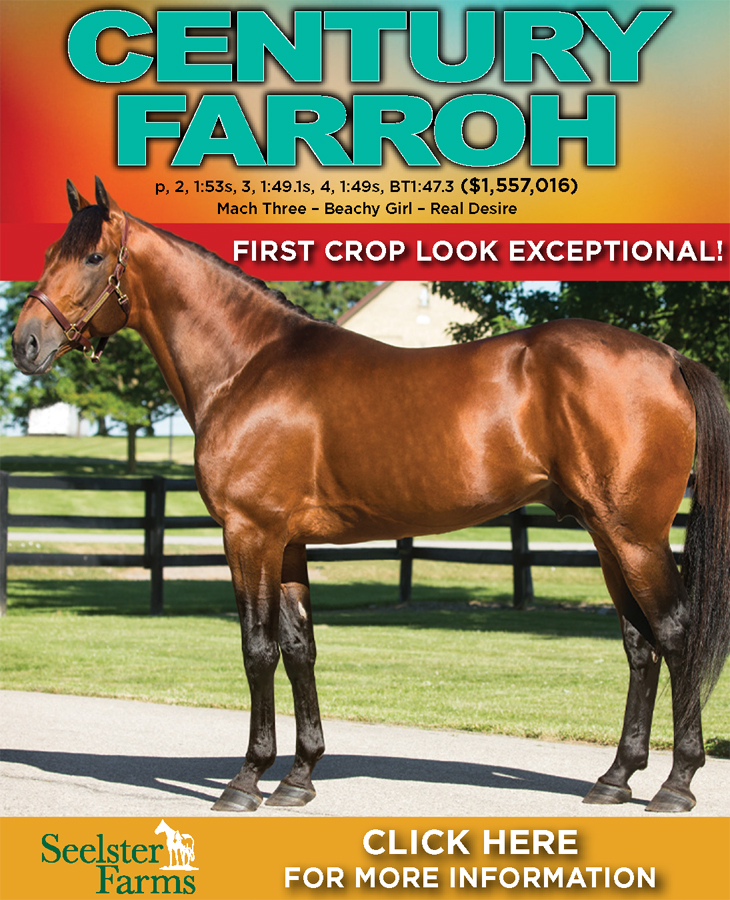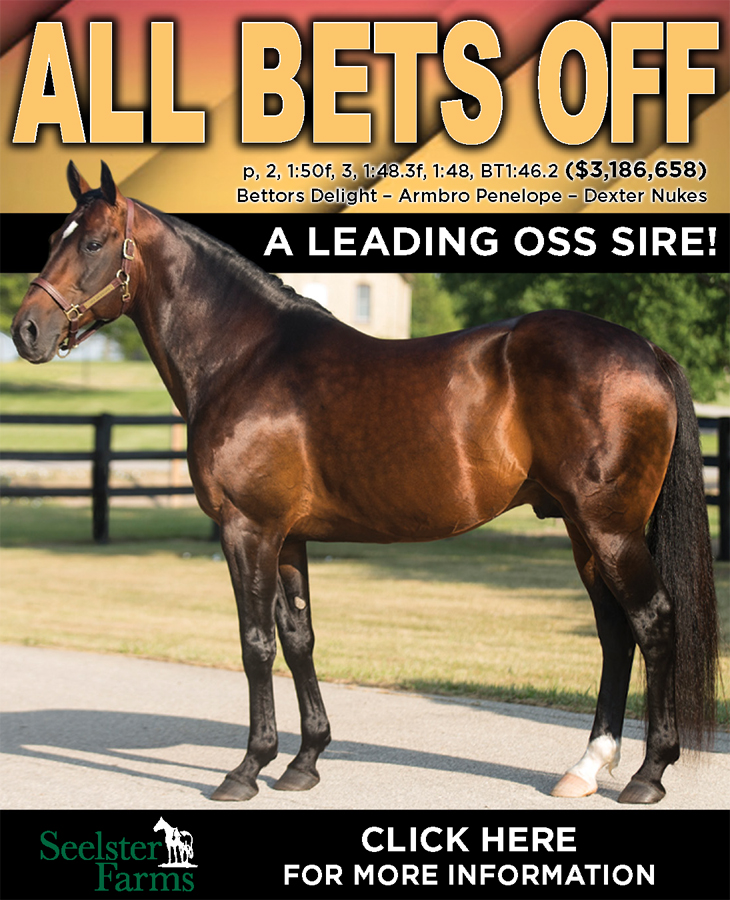

The 57 Hambletonians I’ve witnessed
Part 2 — The Meadowlands through the end of the 20th century.
by Murray Brown
Part 1 is here.
1981 — Shiaway St Pat — In terms of a great horse race, it was a quality one. In most other ways it turned out to be a massive disappointment. It was very well promoted, by the ultra-competent Meadowlands staff as well as an all-star team that included the two best PR people in the history of the sport, Stanley F. Bergstein and Joseph Herbert Goldstein. So where did it go wrong? Weather, weather and more bad weather. It started raining early that morning and never stopped. What was expected to be the greatest crowd in the history of the event became a rather disappointing one. It was a four-heat race. The group of horses were far from the best in the race’s history. It was won by longshot Midwest invader, the Michigan-bred Shiaway St Pat with future Hall of Famer Ray Remmen at the lines; a narrow winner over the Howard Beissinger driven and trained Super Juan.
1982 — Speed Bowl — The two pre-race favorites Mystic Park and Arndon made breaks in the early part of the race leaving it open for Jazz Cosmos and Speed Bowl. Speed Bowl won it by a narrow neck driven by Tommy Haughton over Jazz Cosmos who cut the mile over Speed Bowl who sat the deuce. Haughton at 25, became the youngest driver to win the race. His father Hall of Famer W.R. “Billy” Haughton watched the race from the track dining room. “Tommy gets along with this colt better than I do” said the proud father when asked why he wasn’t in the bike on Hambletonian Day.
1983 — Duenna — One of the most heart-rending results in Hambletonian history. It was a filly year with the fillies Duenna and Winky’s Gill finishing 1-2 in the race. Stanley Dancer, Duenna’s trainer/driver had expected to win the race, but with another horse, Dancer’s Crown. A few weeks before the race, Dancer’s Crown, a horse that Dancer had likened to his great champion Nevele Pride, had died from colic. Dancer expected to be watching the race from the grandstand. He was persuaded by Norman Woolworth, the owner of both the late Dancer’s Crown and the filly Duenna, to enter her in the race. Dancer complied with Woolworth’s request and won fairly easily in straight heats over a racetrack that was rated sloppy for the final heat.
1984 — Historic Freight — The fourth gelding to win the Hambletonian during my time in the sport. Lots of records in this one. The richest Hambletonian to that point; the purse was $1,219,000. The race featured the most declared in to race at The Meadowlands with 26 entered. Historic Freight was the only winner who anyone could have owned. He could have been claimed for a tag of $52,500 before winning a claimer a few weeks prior to the big race. Another four-heat battle. Gentle Stroke won the first one. Delvin G Hanover, the sentimental favorite won the second with his namesake 69-year-old Delvin Miller in the sulky. The third was captured by Historic Freight, after his driver Benny Webster put the field to sleep cutting slow fractions before holding off Delvin G Hanover at the wire. Webster weaved his magic in the final, once again holding off Delvin G Hanover at the finish. His owner Arthur J. Brown was the original owner of the Brooklyn Nets basketball team, then called the New York Americans and subsequently the New York Nets and the New Jersey Nets.
On a personal note that I was witness to, Brown and John Simpson Sr. had been friends and colleagues together back in the ’50s when Brown had the best horses of his ABC Freight Forwarding Stable residing in the Simpson stable. By 1984, Simpson, who was now totally blind was approached by Brown following the race. ‘Hello, Johnny,’ Brown said. ‘Congratulations, Arthur,’ Simpson responded without the slightest hesitation. The two men had not spoken for over 20 years, yet Simpson recognized Brown’s voice.
1985 — Prakas — He was the best heading into the race and if it was possible even better after his easy win. Another of my couldn’t miss stallion prospects who turned out to become less than adequate in the stud stable. One important lesson learned though. Prakas was less than a perfect individual. Even though he could live with his physical faults, a lot of his sons and daughters could not. He sired a good many individuals who were prone to lameness. That, to a great degree, contributed to his lack of success in the breeding shed.
1986 — Nuclear Kosmos — The first all-Scandinavian win. In actuality, an all-Norwegian win. Trainer Per Henriksen imported his friend Ulf Thoresen to East Rutherford to drive his Hambletonian hopeful Nuclear Kosmos. The limited few who had seen Thoresen drive thought him to be among, if not the very best driver in the world. The diminutive Thoresen certainly did his reputation no harm in securing the win for Nuclear Kosmos. It turned out to be an all-Scandinavian finish, with Royal Prestige finishing second by a neck teamed by Sweden’s Berndt Lindstedt.
1987 — Mack Lobell — A truly great horse who won the race cutting the mile and drawing away in a stakes record of ١:53.3. This was a particularly great field which included Mack’s nemesis Napoletano, who sometimes, but rarely was able to defeat Mack Lobell. This was the first of John Campbell’s six Hambletonian wins. The horse that pushed Mack to his record time was Waikiki Beach who was exported to Italy and sired Varenne, the horse that some consider to have been the greatest trotter ever. Ironically neither Mack Lobell nor Napoletano were near as sensational in the stud barn as they had been on the racetrack.
1988 — Armbro Goal — John Campbell was back for his second consecutive Hambletonian win, once again in easy wire-to-wire fashion for owner Tomas Bertmark who bought the colt on the eve of the race. His trainer of record was Jan Johnson, but in actuality the colt was trained by the Continental Farms trio of Johnson, Lindstedt and Hakan Wallner. In his post-race interview Bergstein makes reference to the perceived Scandinavian “takeover” of American trotting. That continues to this day with Swedish born Nancy Takter the trainer of the 2023 winner Tactical Approach. If ever a horse was destined to become a Hambletonian winner, that horse was Armbro Goal. His sire Speedy Crown was a Hambletonian winner, his dam Armbro Flight was a multiple stakes winner and her dam, Helicopter won the Hambletonian. The undercard that day featured the Hambletonian Oaks which was won by Nan’s Catch, a great filly in her own right, but perhaps best known as the dam of the great international champion Moni Maker.
1989 — Probe and Park Avenue Joe — At the outset of the racing year, the previous year›s 2-year-old champion Valley Victory was expected to be the favorite coming into the race. But illness or unsoundness, take your pick, maybe even a combination of both prevented him from showing up for the race. To many, but not including me, this was the most exciting Hambletonian ever. Perhaps it was the most mystifying one. Who would have ever thought that trotting’s greatest race would end up in a dead heat between two relatively average horses? The Hambletonian Society ruled that Park Avenue Joe was the winner based on his overall standings in the heats. The connections of Probe brought suit saying that was wrong. After some time and I assume the fattening of some lawyers’ pockets the case was settled out of court with the original ruling of Park Avenue Joe being the winner accepted. The best horse in the race was the magnificent filly Peace Corps who finished second to Park Avenue Joe in his first heat win. She would go on to win a record four Breeders Crowns.
1990 — Harmonious — This was the richest Hambletonian at that time with a purse of $1,340,000. As history would prove, the second of four consecutive races won by, in relative terms, a relatively ordinary trotter in a rather ordinary group. It was Campbell’s third win in the trotting classic and his third in the previous four years. It was also the Antonacci family’s fourth Hambletonian winner. The trainer Osvaldo Formia had trained his previous winner of the race the previous year with Probe’s dead heat win. Formia had also been the groom of Hambletonian winners Lindy’s Pride and Speedy Somolli.
1991 — Giant Victory — A very nice horse who happened to be the best on that day. The race represented trainer Per Eriksson’s second Hambletonian victory and the first by driver Jack Moiseyev. There wasn’t much to separate Giant Victory and another heat winner M B Felty, another son of Super Bowl who was trained by Ronnie Gurfein. It was the fourth win for a son of Super Bowl.
1992 — Alf Palema — This was the third Hambletonian win for trainer Eriksson and the first for driver Myles “Mickey” McNichol. It was an extremely exciting race featuring a daring three wide move by the filly Armbro Keepsake on the leader King Conch who held on before being narrowly edged out at the wire by Alf Palema who snuck through on the rail. Alf Palema then went on to become a decent sire in Sweden.
1993 — American Winner — The first Hambletonian winner in several years won by a truly great horse, American Winner who in turn defeated another truly great horse in Pine Chip. He was the first Hambletonian winner for trainer Milton Smith, the first for driver Ronnie Pierce and the first for breeder/owner Bob Key. He was the fifth winner for Hanover’s Super Bowl. Nobody loved to race more than Bob Key. Under Key’s guidance, American Winner won the first 3-year-old trotting stakes event of the year, the Dexter Cup at Freehold and continued unabated through the Hambletonian and then the Zweig Memorial at Syracuse, where he won but appeared to many to be noticeably unsound. Then the proverbial wheel fell off. American Winner was lame and was never again his once great self.
1994 — Victory Dream — The first of Gurfein›s three Hambletonian wins and also the first of Mike Lachance›s four. Some thought it should have been the second, but for a narrow loss by M B Felty in ١٩٩١. It is my belief that Victory Dream was a great horse who history has denied some of the recognition he was due. Perhaps it was because he had fertility problems which compromised him being able to become the great sire that he almost certainly would have become. In his inimitable Gurfein-esque manner, Ronnie once described peanuts as being the size of boulders relative to the size of Victory Dream’s testicles. Despite his fertility issues Victory Dream sired a great trotter and a good sire in Self Possessed.
1995 — Tagliabue — Entering the ١٩٩٥ racing season the Hambletonian, talk centered on a possible match between the previous year’s outstanding 2-year-old champion Donerail and that season’s great 2-year-old filly CR Kay Suzie. That was not to be. Donerail’s return to action was far from what was expected. He raced a few times for Dancer, but without looking like the colt he had been in 1994. Rather than tarnish his reputation, the syndicate that owned him decided to retire him to stud at Hanover Shoe Farms. Carl and Rod Allen’s sensational filly came into the race as the overwhelming favorite. She made a break at the onset and finished back. The race was won by Tagliabue for the Campbell brothers, driver John and trainer Jim for owners Jules and Arlene Siegel. It was John’s third Hambletonian win and Jim’s and the Siegels’ first. Tagliabue became the sixth winner of America’s Classic Trotting Race sired by Super Bowl.
1996 — Continentalvictory — This was the most exciting Hambletonian of the ٥٧ I have been to, even though I, in effect, came out on the losing end. I was cheering for Lindy Lane. Hanover had been looking for a son of Valley Victory to stand at the Farms. With the aid of Geoff Stein, a syndication deal had been put together for Lindy Lane to stand at Hanover at the conclusion of his racing career. Continentalvictory had also been racing extremely well for the duo of Gurfein and Lachance. But there was a problem. Lachance was the driver of both horses and he would have to choose between the two. People wondered which horse Lachance would choose.
In addition to possibly picking the wrong horse if he chose to drive the filly, he would be giving up lifetime breedings by picking away from Lindy Lane. Nevertheless, he picked Continentalvictory. To this day, I believe he made his choice entirely out of friendship and loyalty to Gurfein. At the time, it was tough to choose between the two. I’m fairly certain that he didn’t know that Continentalvictory was destined to become the better. Continentalvictory of course won the race over Lindy Lane. Neither horse was quite as good after the race. Another interesting trotting filly was on that race card. A filly by the name of Moni Maker won the Hambletonian Oaks on the same day, her first major win of many to come.
1997 — Malabar Man — The race was won by a very good, perhaps great, horse over a decent bunch that included the previous year’s top colt Yankee Glide. The thought was that Yankee Glide was the best of the bunch. This was not to be Yankee Glide’s best day. It seemed he just didn’t have much trot. Malabar Man was driven by his amateur owner Mal Burroughs and was trained by Triple Hall of Famer to be Jimmy Takter. The outcome was marred by a bit of controversy when race leader Bowlin For Dollars bore out in the stretch opening the rail for Malabar Man and Burroughs. Bowlin For Dollars’ driver Trond Smedshammer was handed a penalty by the judges, which he appealed and which subsequently was overturned.
1998 — Muscles Yankee — A super horse who was destined to become a super sire. Campbell›s fifth Hambletonian, trainer Chuck Sylvester›s first and the first for a partnership that included breeders Bill Perretti and Herb Liverman. Muscles started fairly slow at 2 and then progressed to the point where he was the best in North America. At 3, he was clearly the best. He was retired to stud at Perretti’s Perretti Farms where he assumed a role as one of the premier trotting sires in North America.
1999 — Self Possessed — Once again, the Gurfein-Lachance duo visited the Hambletonian winner’s circle at The Meadowlands; both for the third time. In the race, Self Possessed set a world record. He defeated a good group which included Angus Hall and Enjoy Lavec. Self Possessed was an extremely fast colt who, at times, was perceived as lacking in soundness and good manners. As a sire, he sometimes produced horses who shared those traits. His best-known offspring was Cantab Hall, who ironically was a well-mannered and sound colt, who is well known for producing sound and well-mannered horses. Such are the vagaries related to breeding horses.
To be continued.














